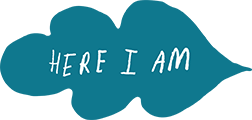A youth-centred approach to designing a sexual health chatbot for Kenyan adolescent girls and young women
Girl Effect — Chatbot
In Kenya, systemic financial, social, and cultural barriers contribute to a lack of girls' agency in making decisions about accessing family planning services.
Digital technologies have opened up new ways for adolescent girls and young women to access these products and services online. However, there are still too many barriers that prevent young women from taking advantage of these options.
In order to build a more inclusive approach and increase reach, Girl Effect brought together young women, service providers, and other key stakeholders to co-create and test prototypes for a new digital product, working with existing platforms to expand access to healthcare across Kenya.
Girl Effect engaged Here I Am to lead on the Human Centred Design and development process for its new sexual and reproductive health and rights (SRHR) chatbot for Kenyan adolescent girls and young women. WAZZII, which launched in September 2023, is a WhatsApp-based chatbot specifically designed to help young women learn about their sexual and reproductive health, and the services available to them.
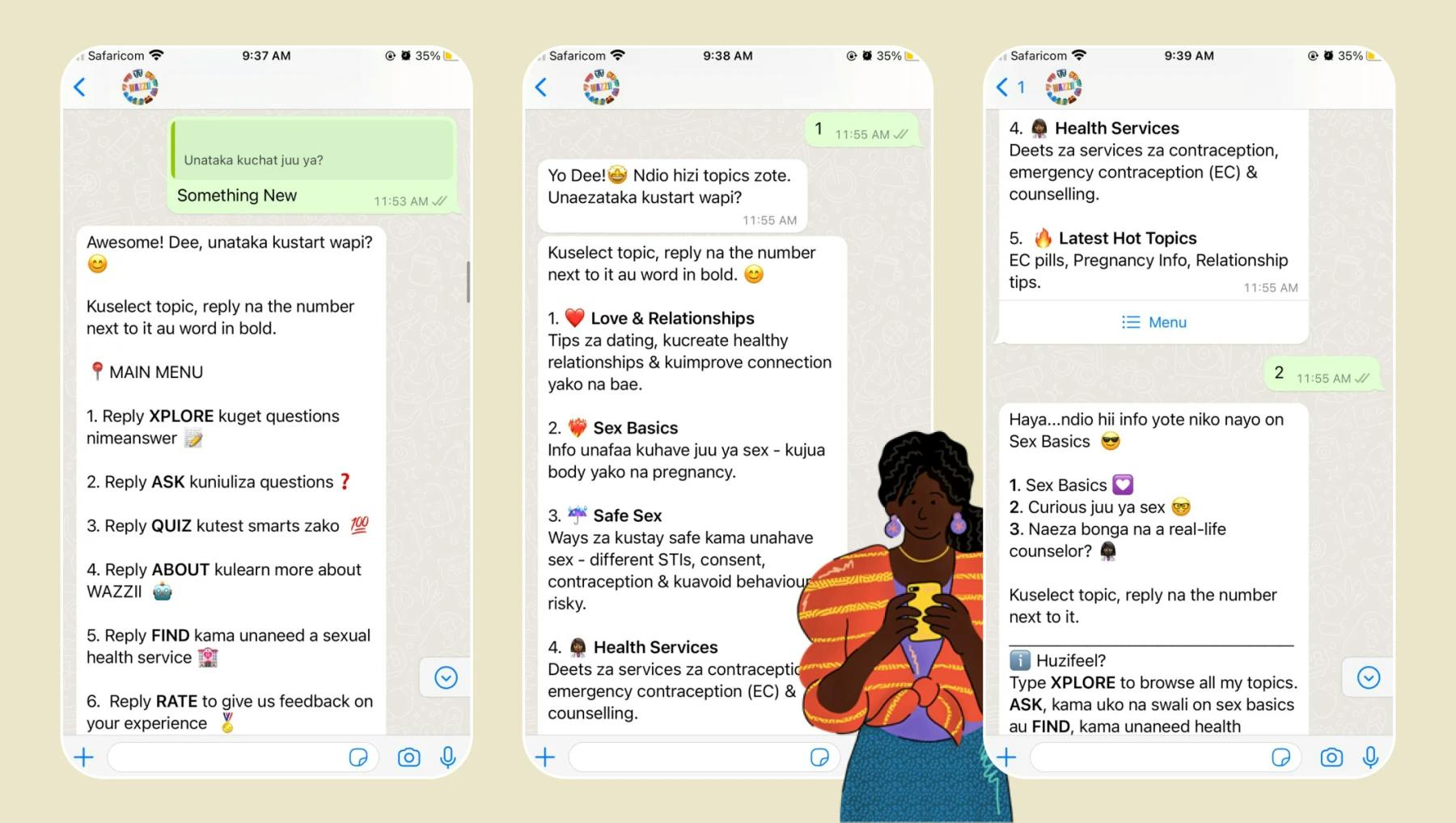
WAZZII, Girl Effect’s WhatsApp-based chatbot
Girl Effect’s WAZZII chatbot provides young people with easily-understandable information in the form of short automated conversations on a variety of SRHR and relationship topics. WAZZII also allows young people to test their knowledge with quizzes, submit a question, view (anonymised) Q&As from other users, or browse a directory of SRHR services near them.
Importantly, WAZZII is designed to reflect young people’s need for additional support when it comes to taking the big step of translating knowledge into action: users can choose to connect with a WAZZII advisor, either via a toll-free number or through a human-in-the-loop interaction on the chatbot itself. The advisors act as a ‘concierge’ by providing any additional information or support a girl might need before connecting them with a service provider.

Youth Creators Approach
Girl Effect includes adolescent girls and young women (AGYW) in the design of all their products and programmes, which aligns with Here I Am’s mission to include the excluded. A key part of our engagement was to develop a Youth Creators Approach to underpin the design of the chatbot, and any subsequent iterations. The Youth Creators Approach lays out our collective vision for working with young people, the principles we would be guided by, along with the concrete steps we would take to do so.
Bringing together learning and best practice from both Girl Effect and Here I Am’s previous work, the Youth Creators Approach involved:
- Creating a Youth Creator group, building on Girl Effect’s existing Youth Advisory Panel of young women, to be actively involved in the ongoing design process
- Defining appropriate touch points, communication channels, and activities for both face-to-face and remote engagements
- Establishing clear safeguarding processes to ensure our Youth Creators had an informed understanding of the terms of engagement
- Implementing clear feedback mechanisms to ensure our Youth Creators felt heard, as well as garnering valuable insights on what did and didn't work about the process.
We agreed on a blended approach, which included face-to-face interactions such as workshops, but didn’t rely on them exclusively. This meant establishing processes to work remotely with Youth Creators via the channel of their choice once an initial face-to-face engagement had taken place. We were also concerned with ensuring that girls who did not have access to a smartphone were not excluded from subsequent collaboration, despite being harder to reach.
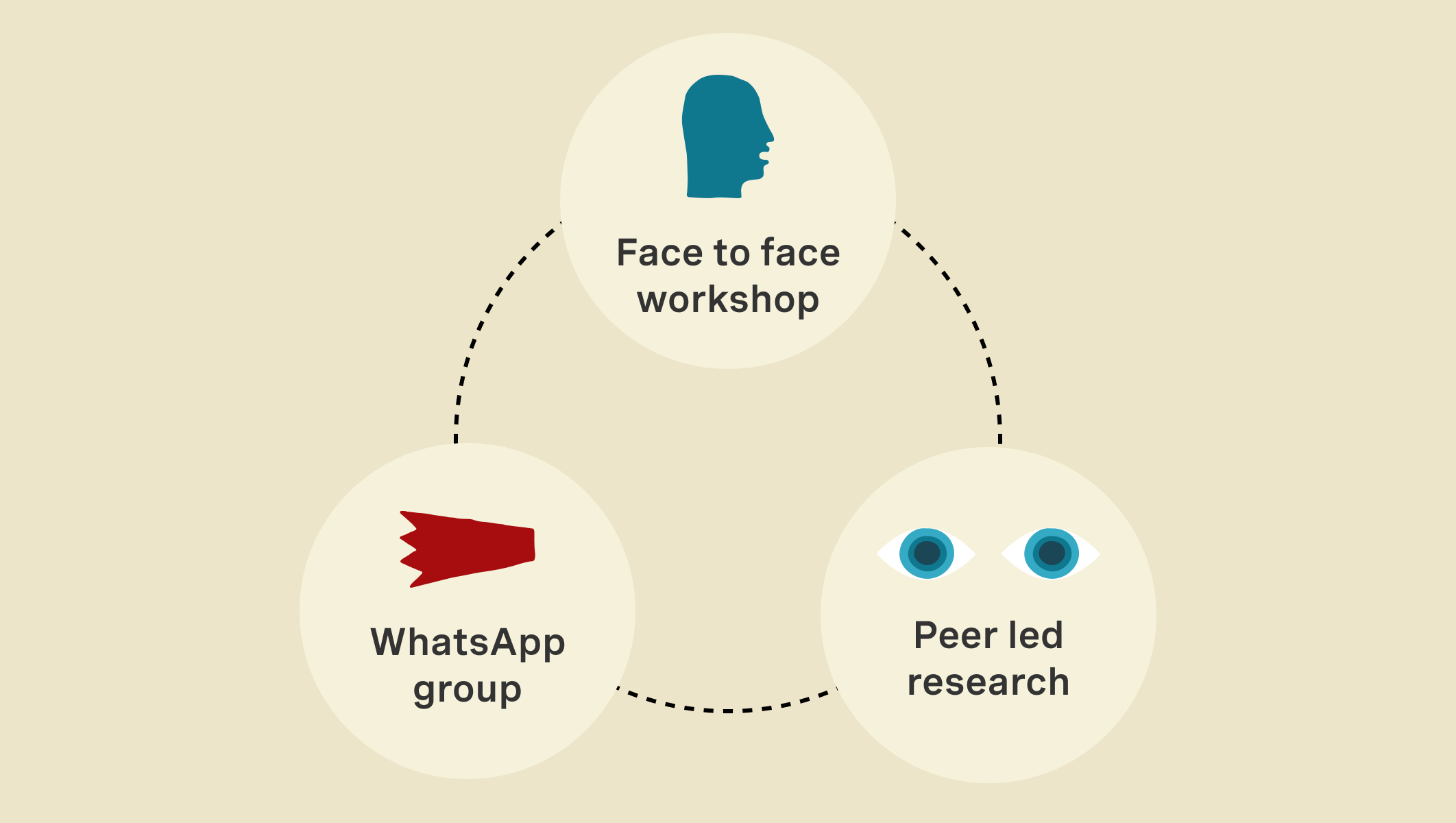
Documenting our intentions, guiding principles, and practical considerations in such detail meant that throughout the design process and beyond, we have been able to easily remind ourselves of our joint commitment to be truly Youth Centred — something extremely valuable when the realities of project implementation inevitably throw up challenges.
Phase 1: Building a rapport; digging deeper
Girl Effect had already conducted a substantial amount of discovery research with their Youth Advisory Panel members and other adolescent girls in Migori and Nairobi before Here I Am was engaged. We therefore already knew that the chatbot we were designing needed to be:
- Accessible (in this case, this meant based on WhatsApp, the channel most used by girls with internet enabled phones)
- Accurate (so they could trust the information it provided)
- Relevant (so they would feel it was designed for them)
- Reliable (so they knew it could be counted on even in a crisis)
However, before we could start designing we had a number of questions we wanted to collaborate with girls on, such as:
- Did they feel the User Personas sketched out during the discovery phase accurately represented a range of realities?
- What should the voice of the chatbot be, including language, tone, and the use of emojis?
- Given that the initial version of the chatbot would not be AI-powered, how should it clearly and sensitively handle the times when it doesn’t understand users?
These questions were best addressed in face-to-face interactions, given their need for substantial context and the abstract thinking facilitated by paper prototypes. Conducting in-person workshops initially allowed us to establish rapport with the Youth Creators, fostering trust and understanding among themselves, our team, and Girl Effect. Additionally, it facilitated the development of a bond among the girls who would be embarking on this collaborative journey over the course of several months.
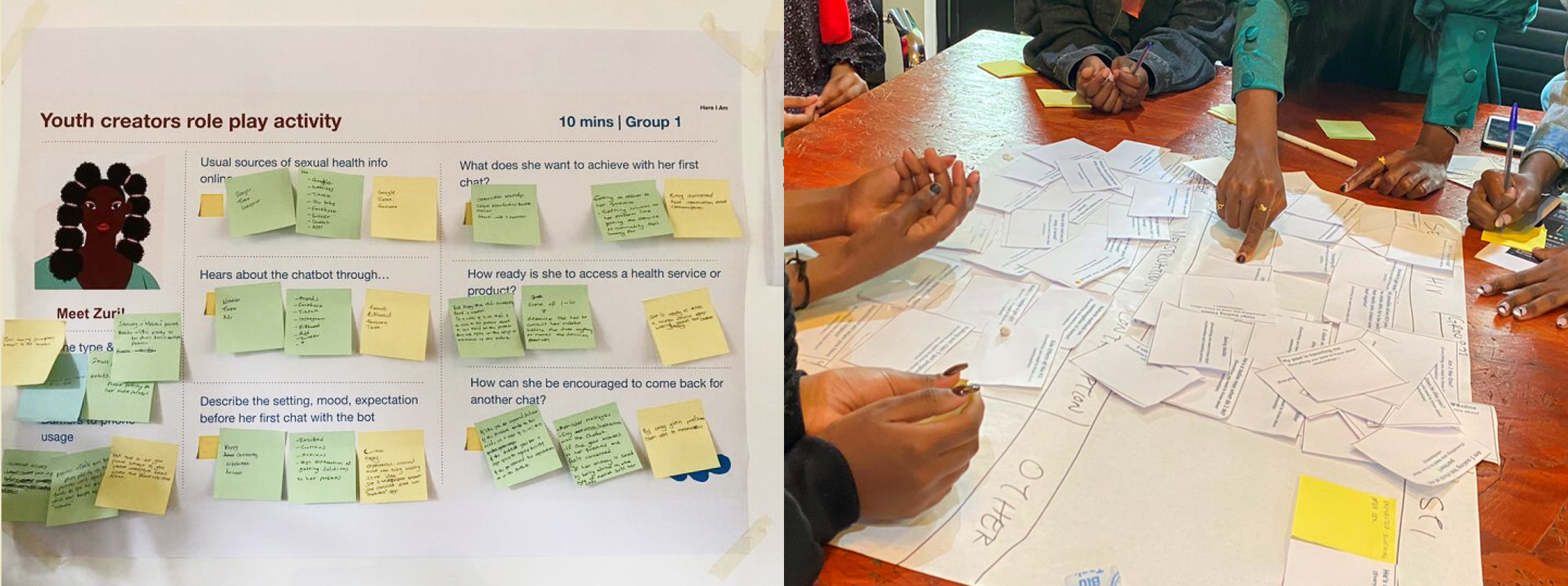
Phase 2: Remote co-creation via WhatsApp
During the face-to-face workshops, we asked the Youth Creators if they were interested in being involved in remote, lighter-touch design activities that would contribute to the final chatbot design. All the girls who took part in the workshop expressed a desire to continue their engagement, and proposed using WhatsApp groups as their preferred communication channel. It’s important to note that in Migori, three of the girls did not have web-enabled phones and we therefore agreed with them to communicate via SMS and phone calls.
The Youth Creators joined a WhatsApp group, where we reiterated the rules of engagement co-designed during the workshops, updating them to be relevant to the digital medium, and with even greater emphasis on keeping the group a safe space. We prepared detailed scripts to guide conversations, to ensure that in the back-and-forth inherent to instant messaging, we didn’t forget to ask crucial questions.
Over the course of six weeks, and with the support of Girl Effect staff, we successfully facilitated remote design consultations on a range of topics which enabled us to fine-tune the final WAZZII designs. This included gathering examples of emojis, gifs or images to use and avoid, presenting back key parts of the chatbot UX design that had been completed since the workshops, and a mini-design challenge which required girls to go away and come up with ideas independently.
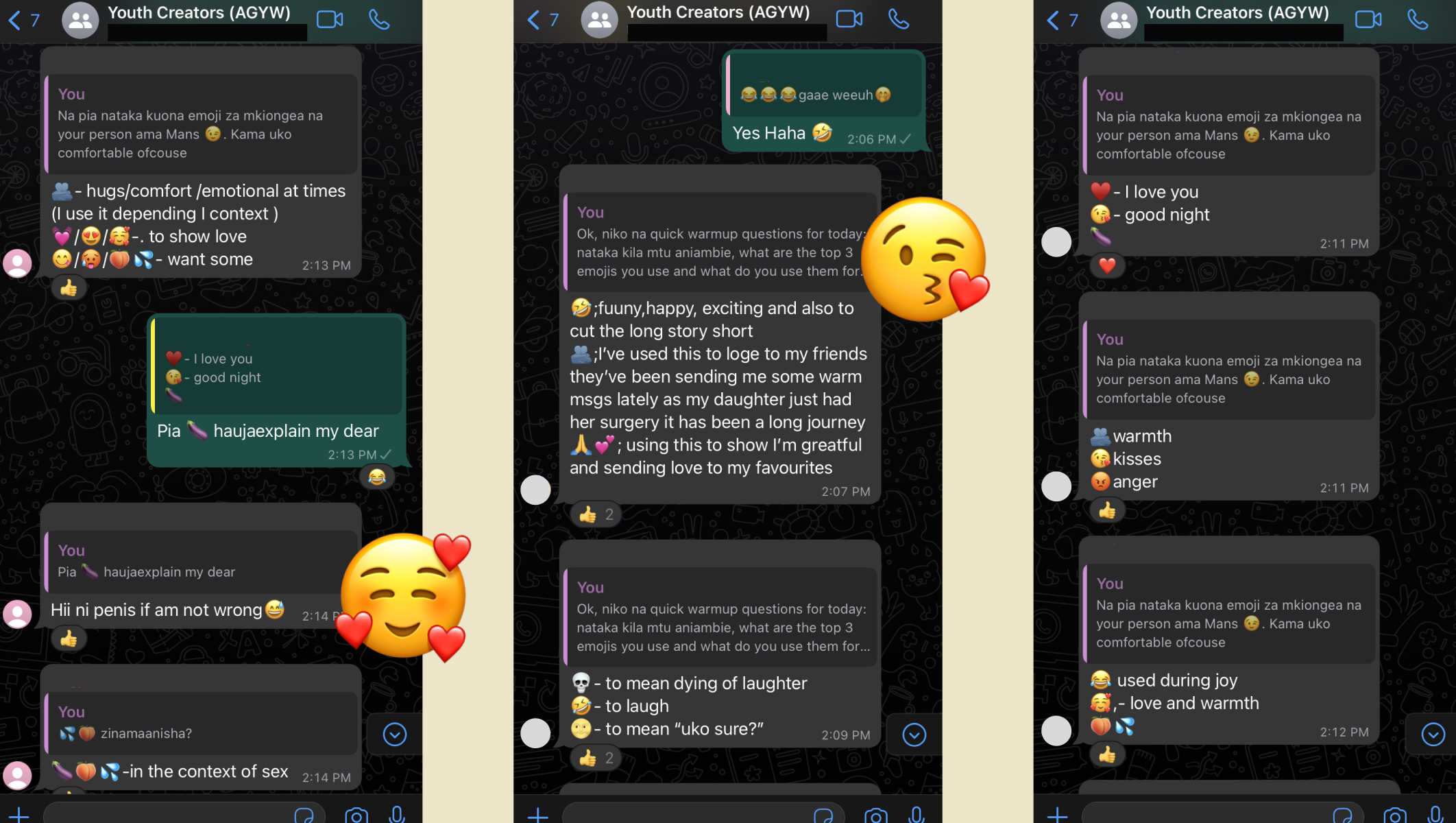
At the end of every conversation, Youth Creators fed back on their experience via polls and open feedback, and we reminded them they were free to modify the terms of their engagement if the commitment became too much. Over the course of these sessions, 88% of girls said the questions they were consulted about were really interesting, 97% said we did well or very well at creating a comfortable conversation, and 94% said they would recommend joining co-design activities to a friend.
What we learned
From both the face-to-face and remote activities, we gathered a wide range of actionable insights that informed the final WAZZII designs, as well as many which could be explored in future iterations. Highlights included:
- The need for additional languages beyond the use of Sheng (a Swahili and English slang), to ensure that the widest range of adolescent girls feel included
- A strong awareness of chatbots even in rural locations, but their introduction would need an additional degree of promotion, for example, in the form of activation events
- The importance of error messages not making users feel stupid
We also learned valuable lessons about our blended approach to co-creation. For example, although the Youth Creators enjoyed the remote experience overall, they emphasised the need for facilitators to stick to stricter timekeeping. They also requested that we should follow up with them regularly about the decisions taken based on their suggestions, using an easy to read PDF document.
However, we also validated our suspicion that sustaining remote engagement with girls without WhatsApp would pose practical challenges. Consequently, Girl Effect is adopting a different strategy when testing the USSD version of the WAZZII service for this demographic. Contrary to our initial belief that WhatsApp might not be conducive to more creative design challenges, the girls surprised us with an impressive response to our design challenge on reaching unconnected girls. Their feedback varied from extensive voice notes to comprehensive documents, offering Girl Effect a wealth of ideas and additional contextual information.
Establishing and holding ourselves accountable to a Youth Creators Approach meant we kept a consistent dialogue with adolescent girls and women in Kenya that ultimately led to the launch of a chatbot which we feel confident is meeting real needs, in a way that resonates with real girls.
Youth Creators also perceived a value in the process that we hadn’t anticipated: learning more about design and technology. As one participant told us: the sessions were interesting and I’m grateful. Not only this, but I have learned more about the world of chatbots and USSD.
Inspired by Chatbot?
Our work with Girl Effect is just the beginning. We'd love to hear about your project and how we can help.
